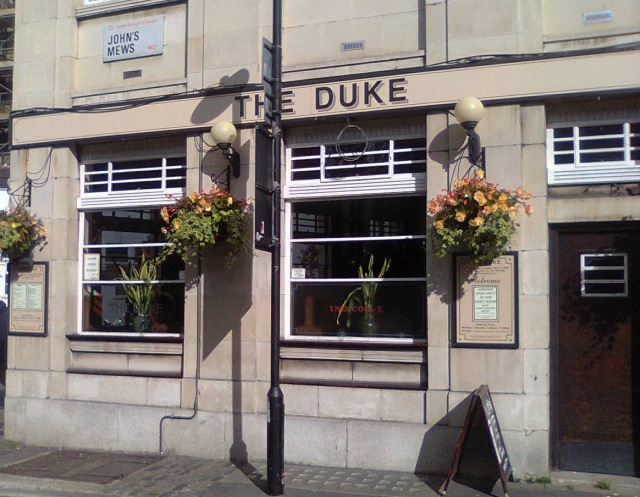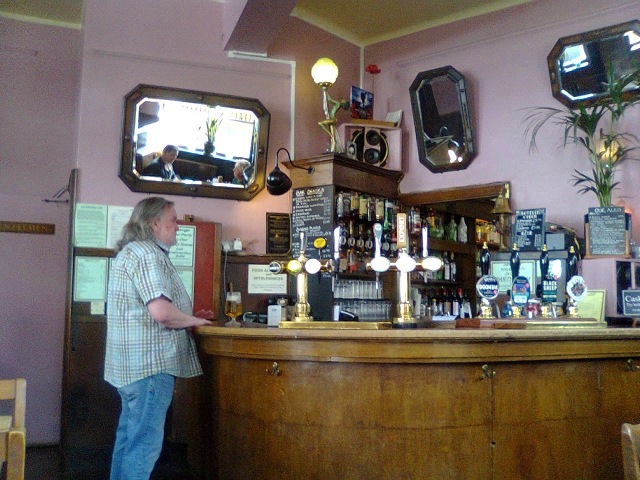7, Roger Street WC1N 2PB
Nearest tube: Russell Square 0.4 miles
Nearest attraction: Charles Dickens Museum 400ft
Historical interest: 7/10
Cosiness quotient: 6/10

The Duke, Roger Street
The hook
If you’ve ever watched Goodnight Sweetheart – a UK sitcom where an ordinary bloke walks down a London street in the 1990s and slips through a time portal that takes him back to the 1940s – you will understand the lure of the Duke. It is every bit as authentic as the wartime pub featured in the sitcom. One glance at its understated exterior with its art deco windows bearing the name of long-lost brewery Ind Coope and you will feel as though you’ve blundered into a similar wormhole of history.
The history
EST: 1938. Monarch: George VI
The opening of any pub in 1938 seems like a supreme act of optimism since this was a time when the rest of the country was building tanks and warships rather than hostelries. Maybe the architects of the Duke of York (as it was called then) suspected that within a year or so, your average Joe was going to be in desperate need of a drink. And they would have been right.
The Duke of York’s earliest customer base was presumably made up of servicemen, air raid patrolmen and assorted Bloomsbury locals, all of whom had a lucky escape when a bomb fell on Roger Street during the 1940s, miraculously leaving it and its customers unscathed.
A mere stone’s throw from the pub is the site of the former London Foundling Hospital.
Foundlings were a real problem in the olden days when birth control was non-existent and an illegitimate baby could ruin a woman’s life. But what to do with all those unwanted offspring? Answer: Leave them in a handy location where they’d be found by someone with a bit of compassion.
Obviously this approach was rather hit-and-miss, compassion being somewhat thin on the ground in 18thcentury London. But it eventually turned up in the most unlikely of places: in the heart of a sea captain.
One usually associates sea captains of old with press-gangs, mutinies and cats-o-nine tails. But Captain Thomas Coram was a different kettle of fish altogether (excuse the maritime metaphor). In fact he was less of a rollicking sailor and more of a kindly philanthropist who set up schools, established libraries and eventually devoted his life to abandoned babies.
His London Foundling Hospital occupied a sprawling site in Lamb’s Conduit Field and attracted thousands of superfluous children. The idea was praiseworthy: unwanted babies under the age of one would be dumped at the hospital by a parent who would be given a receipt so that he or she could claim back their offspring at a later date if they so wished. Babies would be sent to wet nurses in the countryside and then returned to the care of the Foundling Hospital at the age of four or five. And once they became old enough to work they would be apprenticed as servants or into a trade.
Obviously there were a few hiccups in the system, this being the 18thcentury and all. Some vulnerable orphans were abused or even killed: one notorious case led to the hanging of Fanny Brownrigg in 1767 for beating a foundling to death. But in general the system worked surprisingly well and thousands of orphans were successfully rehabilitated.
The foundling hospital eventually moved to Berkshire and was repurposed in the 1950s when fostering and adoption became more prevalent. The flattened Bloomsbury site is now known as Coram Fields, a seven-acre open space incorporating duck ponds, sand pits, a children’s playground, café and nursery. It sounds delightful – but I have yet to experience it first-hand since adults are only allowed in accompanied by a child.
Literally around the corner from the Duke pub is Doughty Street where none other than Charles Dickens used to live in the 1830s. Dickens was appalled by child poverty and would often walk through the grounds of the Foundling Hospital which apparently inspired several of his works including Oliver Twist, which was written during his tenure in Doughty Street. But perhaps even more of a giveaway to the Foundling Hospital’s influence over the great author is the fact that a character in Little Dorritt is a former foundling-turned-servant nicknamed Tattycoram after the place where she grew up.

Inside the Duke
The ambiance
The stylised interior of the Duke delivers on the promise of the outside and there’s a bright red piano, wooden window booths, school-dinner-style tables, parlour palms and art deco lighting. In fact it’s all a bit bewildering since the venue doesn’t actually scream “pub”. But presumably this is what pubs looked like in the 1930s, and who am I to quibble with the genuine historic article?
The other stuff
Brewery/chain: Free house
Open: Monday-Saturday midday-11pm, closed Sundays
Food: Monday-Saturday 12.15pm-2.30pm and 5.30-9.30pm
The Duke is your typical corner local where you can enjoy a pie, a pint and a chat with the bar staff. The food is exactly what you might expect from a 1930s boozer – traditional British ploughman’s lunches, bangers-and-mash and the inevitable fish ‘n chips are all to be found here. In fact it’s the ideal place for the nostalgic drinker who mourns the olden days when the pub was the hub of the community.
http://www.dukepub.co.uk/?LMCL=Ucwr4c
For a complete list of pubs, go to the home page.
To see a list of pubs by their nearest tube station, go to Where’s my pub?
To narrow down your search click on My Faves.
Visit: King Who? for more info about the monarchs mentioned in this blog.
And follow me on Twitter at: @PubsPoemsPast